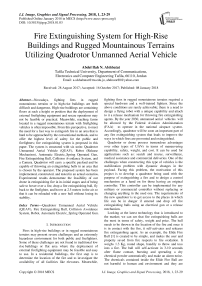Fire extinguishing system for high-rise buildings and rugged mountainous terrains utilizing quadrotor unmanned aerial vehicle
Автор: Abdel Ilah N. Alshbatat
Журнал: International Journal of Image, Graphics and Signal Processing @ijigsp
Статья в выпуске: 1 vol.10, 2018 года.
Бесплатный доступ
Nowadays, fighting fires in rugged mountainous terrains or in high-rise buildings are both difficult and dangerous. High-rise buildings are containing floors at such a height or position that the deployment of external firefighting equipment and rescue operations may not be feasible or practical. Meanwhile, reaching farms located in a rugged mountainous terrain with firefighting vehicles is often impossible. From this perspective, to meet the need for a fast way to extinguish fire in an area that is hard to be approached by the conventional methods, and to offer the highest level of safety for the public and firefighters; fire extinguishing system is proposed in this paper. The system is structured with six units: Quadrotor Unmanned Aerial Vehicle (QUAV), Robot (Release Mechanism), Automatic Electric_Spring Operated Gun, Fire Extinguishing Ball, Collision Avoidance System, and a Camera. Quadrotor will carry a specific payload and be capable of throwing an extinguishing balls in an area that is chosen by the operator. The proposed system has been implemented, constructed, and tested in an actual scenarios. Experimental results demonstrate the feasibility of our drone in extinguishing fire in its initial stages and of being safe to hover over a fire, drop a fire extinguishing ball, fly back to the firefighter, and hover at 2.5 meters in the air so that it can be reloaded with a new ball without losing its stability.
Quadrotor Unmanned Aerial Vehicle (QUAV), Fire Extinguishing Ball, Collision Avoidance System, Robot, Automatic Electric_Spring Operated Gun
Короткий адрес: https://sciup.org/15015929
IDR: 15015929 | DOI: 10.5815/ijigsp.2018.01.03
Текст научной статьи Fire extinguishing system for high-rise buildings and rugged mountainous terrains utilizing quadrotor unmanned aerial vehicle
Published Online January 2018 in MECS and Computer Science
Fires in high-rise buildings or in rugged mountainous terrains may present severe challenges and an extremely hazardous environment for both public and firefighters. Some of these challenges are not found in traditional low rise buildings or flat area where the deployment of external firefighting equipment may be feasible and easy to use. In a residential buildings, the first step is to determine the location of the fire and to investigate the availability of all facilities like elevators. Meanwhile, fighting fires in rugged mountainous terrains required a special hardware and a well-trained fighters. Since the above conditions are rarely achievable; there is a need to design a flying robot with a unique capability and attach to it a release mechanism for throwing fire extinguishing agents. By the year 2030, unmanned aerial vehicles will be allowed by the Federal Aviation Administration (FAA) to operate in the national airspace system. Accordingly, quadrotor will be soon an important part of any fire extinguishing system that leads to improve the ways in which fires are prevented and extinguished.
Quadrotor or drone possess tremendous advantages over other types of UAVs in terms of maneuvering capability, safety, weight, and cost. It can be used for applications such as: search and rescue, surveillance, medical assistance and commercial deliveries. One of the challenges when constructing this type of vehicles is the stabilization problem with dynamic changes in the payload. Facing this problem, the motivation of this project is to develop a quadrotor being used with the purpose of extinguishing a fire and to design a control mechanism as a hand on for those having an original controller. This controller can be implemented for any military or commercial controller without replacing or changing anything in the used one. The requirements of the new quadrotor is to get access to the places in which life can be in danger if entered and drop off fire extinguishing balls using an electrical gun or a release mechanism.
Looking at the latest technology that is introduced to the market; we can see that fire extinguishing balls are the most in terms of safety, weight and price. The ball needs to be thrown in the location of the fire and once it is in contact with the fire, it self-activates and releases fire extinguishing agent. As an example, the Elide Fire Ball [1] is created to be simple, and makes the user and property saved from fire respects to fire oxidation. It weighs 1.3 Kg, round shape, handily to throw and toss into a fire. The ball will self-activate in 3-10 seconds after flame contact, bursting and spreading a dry chemical powder automatically and make an alarm noise. The chemicals contained inside the Elide Fire Ball are not harmful to human and environment and they are certified by standard laboratories from many countries.
The core objective of this project is to develop a compact, lightweight and low power consumption aerial system that will help people being affected by fires. The aerial system will be divided into four subsystems. Each part will be designed, tested separately, and then the whole system will be integrated as a one unit. The first unit will be the quadrotor. Quadrotor is going to be built using off the shelf components. Our design will comply with all requirements to extinguish a fire and to be able to stabilize the vehicle while throwing the balls. For this purpose, we will design a robust algorithm that combines payload variation with the main on-board flight controller. This algorithm should meet the need for a fast way to extinguish a fire, and offer the highest level of safety for the operator. Once this system is up and running, a camera is going to be added to the vehicle. The use of the camera in this project is to help in taking quadrotor to the places desired by the controller. The second unit is the automatic electric_spring operated gun. The gun will be fabricated using light materials, its range will be up to 20m and will be controlled remotely. The third unit will be the fire extinguishing ball and the robot. The ball will be similar to the Elide Fire Ball [ 2], and will be filled with a dry chemical powder and being of the explosive type in which it does not present any serious hazard in its actuation. Its weight will be 200g. The last unit will be the collision avoidance system. Fuzzy-based obstacle detection and avoidance system will be used for the purpose of guiding drone inside the buildings.
The main contributions of the paper are: (i) Designing a lightweight product that combines an explosive device with a dry chemical powder and is efficient for fighting fires in rugged mountainous terrains or in high-rise buildings. (ii) Designing a lightweight gun and a release mechanism that are capable of launching fire extinguishing ball up to 20m. The gun will be attached to a camera so that it helps in taking quadrotor to the places desired by the controller and recording what is going on in its surroundings. (iii) Developing a quadrotor unmanned aerial vehicle that is capable of carrying the proposed products and meets the system’s requirements. (iv) Integrating the payload variation with the main onboard flight controller, which make the system accurate in correcting any variations in quadrotor’s height and speed and accurate in an identification the location of the fire. (v) Deploying a decision-making methodology by sending fire’s location to the ground, and thus guaranteeing that there is less chance of people getting injured during mission achievement.
The remainder of this paper is organized as follows: The next section will start with a survey of current research regarding the technologies that are employed with the aim of using Drones for detecting and extinguishing fires. In Section 3, we explain the main scenario of this project in extinguishing fire in its initial stages using quadrotor’s platform. Section 4 details the system architecture, hardware design, software design, and stabilizing control system. In Section 5, we present the experimental results and finally, we conclude and discuss future work in section 6.
-
II. Related Works
Recently, drone technology has been advanced to the point in which its usage needs little or no training. By the year 2030, unmanned aerial vehicles will be allowed by the Federal Aviation Administration (FAA) to operate in the national airspace system. Accordingly, drone will be soon an important part of any fire extinguishing system that leads to improve the ways in which fires are prevented and extinguished. A number of systems have been proposed for the purpose of extinguishing process. The authors in [3] proposed a release mechanism to be mounted on the bottom of the frame of the quadcopter. They proposed a cage and a railing system to hold the Elide Fire Extinguishing ball. The cage used to hold the fire extinguishing ball, and the rails served to guide the ball to its target while the quadrotor hovering over the flame.
In [4], the authors proposed a new firefighting Drone to control and supply a solution using CO2 Boll extinguisher. They equipped the drone with a thermostat detector in order to notice the fire over a particular area. The same technique was proposed in [5], the authors proposed a robotic fire extinguishment approach and a prototype of an aerial extinguisher with an inert gas. The prototype can transport only a small volume of an inert gas, and it can extinguish a very small flame. In [6], the authors also proposed a robot that consists of a control station, quadcopter, dropping device, and fire extinguishing device. Liquid in a capsule was proposed to be the fire extinguishing device. It was used for suppression of class A and class B substances.
Vision-based detection technique was researched in many articles. A set of image processing algorithms that is capable of effectively detecting and tracking forest fire was developing [7, 8, 9]. Those techniques have become a key component in the UAVs-based forest fire detection system. The Authors in [10] proposed a fire detection algorithm that force the quadcopter to track the fire and estimate its position. Having the same idea, but with different approach; a quadcopter, equipped with sophisticated components to capture and transmit the image or video to the data base was proposed in [11]. The author demonstrates the adoptability of quadcopter in acquiring and communicating information in hazardous environment.
The authors in [12] proposed a monitoring software that is used to process UAV aerial data. The software provides the geographical location of the fire and generates a report for the command and control center. Other researchers were studies the potentialities of multiple UAVs technology for several forest-fire related activities. The authors in [13] have been reviewed different types of UAVs for their use and applicability for forest-fire fighting. As the author did in [12], they proposed the use of a camera to generate a clear image to the affected area. In their project, a fleet of heterogeneous UAVs was applied for forest-fires detection, confirmation, localization and monitoring. A system of multiple UAVs was also described in [14] for the same purpose mentioned before. The UAVs were able to fly autonomously over an area of interest and generate an overview image of that area. Consequently, by reviewing all mechanism we came to a conclusion that a multipurpose aerial system is necessary to extinguish fire when it is found.
-
III. Methodology
The main scenario of this project is to extinguish fire in its initial stages using an Unmanned Aerial Vehicle (UAV) platform in a short period of time. In order to accomplish the necessary functions that the UAV will execute, two sub-scenarios are designed in this project: Fighting fires in rugged mountainous terrains, and fighting fires in high-rise buildings.
-
A. Fighting fires in rugged mountainous terrains.
In this scenario, firefighting drone is mainly equipped with a robot (release mechanism), camera, one ultrasonic sensor and four flame sensors. At the beginning and after reaching fire’s location, the system will be semiautomated in such a way that only take-off and landing will need to be controlled but once in the air at the desired altitude from the take-off point, the system is able to continuously monitor the temperature. If the temperature increases beyond a predetermined threshold value (min_temp), drone will fly to the direction to which the temperature is recorded to be relatively maximum among the four sensors. Firefighter at the ground will be able to monitor the location of the fire using the installed camera. Once the drone is hovering over a fire, the system will drop the fire extinguishing ball, and fly it back to the firefighter, and let it to hover at 2.5 meters in the air so that the firefighter can either reload it with a new ball or land it without losing its stability.
-
B. Fighting fires in high-rise buildings.
In this scenario, firefighting drone is mainly equipped with a gun, collision avoidance system, and a camera. As we did in scenario (a), drone will fly to the desired floor in which the fire is taking place. Accessing specific rooms in the structure will be through a window, this window has to be open and the drone will eject the ball in a way that it will fall inside the desired room. Meanwhile drone will stay outside the area on fire. Automatic electric_ spring operated gun will launch three balls up to 20m. The size of the ball is smaller than the original one; it is 5cm in diameter. Reloading drone is the same as in scenario (a). Our near future plan is to have a mechanism to open a window and let the drone getting inside the floor. This can be done by using a solid ball to break the window and then using the collision avoidance system and the camera to guide drone to the fire’s location.
-
IV. Architecture of the Fire Extinguishing System
To meet the need for an efficient, reliable, and fast way to extinguish fires in rugged mountainous terrains and high-rise buildings, we developed a practical lightweight system that consists of Quadrotor Unmanned Aerial Vehicle (QUAV), Automatic Electric_Spring Operated Gun, Robot (release mechanism), Collision Avoidance System, Camera, and Fire Extinguishing Ball, figure 1. In the following subsections, we will describe the system architecture, hardware components and software architecture.
-
A. Quadrotor
Our prototype developed in this project is called Fire Fighting Drone (FFD), figure 1(a). FFD is an autonomous, power-efficient aerial vehicle which is responsible for caring a specific payload and be capable of throwing an extinguishing ball in an area that is chosen by the operator and hard to be approached by the conventional methods. The FFD’s dynamic model have been first developed in Matlab Simulink. After attaining satisfactory results, the controllers were implemented on a real Drone. The details are presented in the following subsections.
-
1) Mathematical Model of the FFD
Two reference frames are needed to model the drone: the earth inertial frame and the body fixed frame. The vector describing the linear and the angular positions of the Drone is given by: p=[ x y z Φ θ ψ ]T. where Φ, θ , and ψ denote the vehicle’s roll, pitch, and yaw angles along the three orthogonal body axes x, y, z, respectively. The airframe orientation can be written as: R = R(Φ). R(θ). R(ψ).
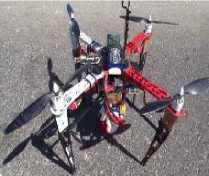
(a)
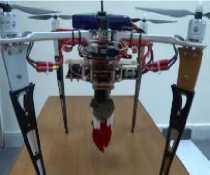
(b)
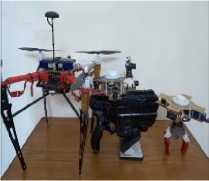
(c)
Fig.1. Fire extinguishing system: (a) Quadrotor unmanned aerial vehicle, (b) QUAV equipped with a release mechanism, (c) The whole system: quadrotor, gun, and robot.
[сб.сф sФ.sб.CTp - cФ.sф сФ. s6. ср + sФ. s/"| cб.sф сФ.ср + sб.sФ.sф s6. сФ. sp - sФ. ср
-
-s6 sФ.cб сФ.сб J
Where, R(Φ), R(θ), and R(ψ) denote the rotations along x-axis (roll), y-axis (pitch), and z-axis (yaw), respectively. (s) represents the sine, and (c) represents the cosine. The dynamic behavior of the Drone was expressed mathematically in [15] as:
x = D m v1(cos(Ф). sin(6) . cos(p) + sin(Ф) . sin(p))
у = D m v 1 (sin(6). cos(Ф). sin(p) - sin(Ф). cos(p))
z = Dmlt1(cos(Ф). cos(б)) - g(4)
Ф = u2 LDm/jx(5)
б = u3 LDm/jy(6)
p = v.4C/jz(7)
-
2) Mechanical and Electrical Structure of the FFD
Q450 glass fiber frame is chosen for this project. Four brushless three-phase out-runner DC motors rated for 920KV are used in this project. Four (10x4.5) inch propellers are mounted on the motors, two pieces for a standard rotation and two pieces for right-hand rotation. The propeller is attached to the DC motor through a standard accessory pack. A multi-rotor flight control board is attached to the central hub, figure 2. This board consists of 32-bit STM32F427 Cortex M4 Processor, 168 MHz clock source, 256 KB RAM, 2 MB Flash, 32 bit STM32F103 failsafe co-processor, ST Micro L3GD20 3-axis 16-bit gyroscope, ST Micro LSM303D 3-axis 14-bit accelerometer / magnetometer, Invensense MPU 6000 3-axis accelerometer/gyroscope, and MEAS MS5611 barometer. To control the speed of the DC motors and thus control the quadrotor, the flight control board is attached to a 30A brushless speed controller (ESC). The Cortex M4 Processor takes sensor inputs and directly controls the four motors by varying the PWM signals sent to each of them. A LiPo battery is attached to the
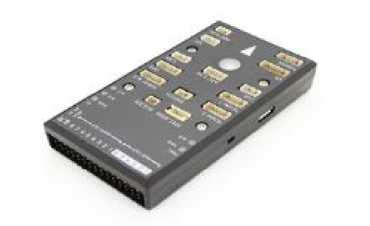
Fig.2. HKPilot32 multi-rotor flight control board quadrotor (4500mAh, 3S). The battery is used to power the flight control board, the ECS’s and the DC motors through a power distribution board.
-
B. Robot ( Release Mechanism)
The goal is to design a robot that is easily hooked up to the drone and be capable for throwing a ball into fire. As shown in figure 3, The robot consists of: Mechanical claws, Arduino Nano board, High torque DC motor, Gear box, 5v regulator, 5V two channel relay module, RC Receiver, and LiPo battery (1300mah 2S). Claws are designed so that they will open and close whenever the firefighter presses the control button on the quadroter’s remote control, which will relay a radio signal to the RC Receiver. The signal from the receiver is then triggered the Arduino Nano board to send an electrical signal to the motor that will control this action. All components are powered by 1300mah LiPo battery.
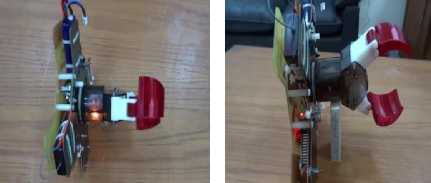
(a) (b)
Fig.3. Robot: (a) Mechanical claws with night light function on, (b) Mechanical claws with night light function off.
-
C. Fire Extinguishing Ball
Fire extinguishing ball is a new technology that combine an explosive device with a fire extinguishing agent. Fires are classified into classes such as class A, B, or C. Class A, B, or C fires can be controlled by dry chemical extinguishing agents. The only all purpose (Class A, B, C rating) dry chemical powder extinguishers contain Monoammonium Phosphate. Monoammonium Phosphate is used in dry chemical fire extinguishers commonly found in offices, schools, and homes.
Our goal in this project is to have a fire extinguishing ball that is activated with the fire without requiring human intervention. As a result, this activation will breaks the ball and disperses the fire extinguishing agent. The proposed fire extinguishing ball is comprised of three basic components: Casing, firefighting agent, and detonating device.
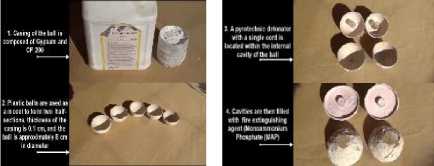
(a)
(b)
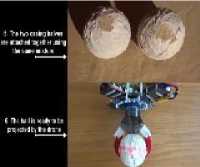
(c)
Fig.4. Fire extinguishing ball: (a) Casing of the ball, (b) Extinguishing agent and pyrotechnic detonator, (c) Fire extinguishing ball is attached to the Robot.
-
D. Automatic Electric_ Spring Operated Gun
The goal is to have a gun that can launch a fire extinguishing ball up to 20m. The materials of the gun are aluminum and plastic, which have a light weight and are easy to manufacture. The gun typically uses a DC motor, which cycles an internal spring_ piston assembly. The DC motor drives a series of two gears mounted inside a gearbox. The gears then compress a piston assembly against a spring. Once the piston is released, the spring drives it forward through the cylinder to push a ball out from the muzzle. To drive the DC motor, we build a small circuit that consists of a servo motor and a push button switch. The servo motor will be attached to unused wireless channel so that the gun can be fired remotely using the RC device dedicated for the quadrotor. On the top of the gun, we attached a collision avoidance system and a video camera. All components are powered by 1300mah LiPo battery and shown in figure 5.
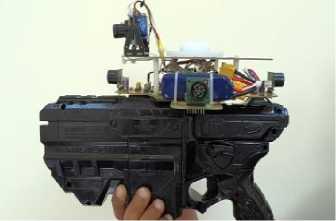
Fig.5. Automatic Electric_ Spring Operated Gun
-
E. Collision Avoidance System
Fuzzy-based obstacle detection and avoidance system is used for the purpose of guiding drone inside the buildings. As shown in figure 6, we build a small, lightweight module with four ultrasonic sensors [16]. The sensors used in this project are XL MaxSonar EZ4. Sensors gather data and send it to Arduino development board, where data is processed and then transmitted to flight-control board.
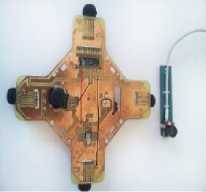
(a)
Fig.6. Hardware architecture of obstacle avoidance system: (a) bottom side of the board, (b) upper side of the board
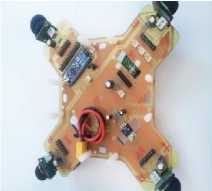
(b)
-
F. Fuzzy Based Stabilizer Control System
Two problems will be appeared as a result of throwing the fire extinguishing balls out the fuselage of quadrotor: Variations in payload, and recoil force. To tackle those problems; fuzzy based stabilizer control system is presented in this project. The system will enable quadrotor to adaptively interact with a dynamic circumstance using a reactive technique determined by sensory information. Sensory Information is gleaned from a distributed sensor array and sent to the fuzzy logic controller. The controller is then command the flight controller to gradually correct quadrotor’s orientation according to the changes in the patterns of the values collected from consecutive frames. The inputs to the flight controller are based on a set of carefully defined linguistic rules. These rules can be bypassed based on the existence of the balls to ensure that the quadrotor is fully compliant with the current mode.
The current version is able to carry only one fire extinguishing ball at a time, which will force the drone to come back to the firefighter in order to continuously reload it with a new fire extinguishing ball. To overcome this problem, we have presented the idea of using a tray of four balls. As shown in figure 7, quadrotor will be loaded with four balls where each one is attached to a sensor (S1_4, S2_3, S3_1, S4_2). Sensors gather data and send it to Arduino development board, where data is processed and accordingly quadrotor is moved in the commanded direction. Commands are obtained through a fuzzy controller and then transmitted to flight control board. The flight controller will decode and execute the commands.
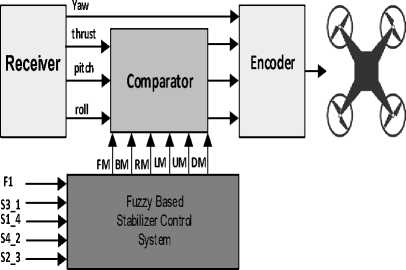
Fig.7. Typical structure of Fuzzy Based Stabilizer Control System
-
V. Experimental Results
Fire Fighting Drone has been evaluated with several real fire experiments in order to confirm the capabilities of the vehicle and other modules. In the first experiment, the tests were conducted only for the structure and electronic systems of the vehicle. During this stage, Drone is tested in regards to the time taken for the takeoff and landing, ease of maneuverability, and how much time it takes to get over the fire. In the second experiment, we equipped the drone with the Robot and examined how the Fire Extinguishing Ball functioning, the time to load the ball, the time to drop the ball, and the time taken by the vehicle to move to the desired location. The gathered data are presented in table 1 and a snapshots for all tests can be seen in figure 8.
As shown in table 1, three balls were tested with a real fire experiment. The tests show that a small affected area can be controlled in its initial state. The range was between 1.8 and 2 cubic meters. This range was acceptable when compared with the size of the ball. To extend this range, we are currently testing our system with a tray of four balls. The design is already presented in section F. The time for the ball to be activated were also varied between five to seven second. We conclude that this variation was due to the difference in wall thickness of the ball's casing. The time to load the ball was not recorded in the table since it differ from one person to another. The recommendations was to train a firefighter from the civil defense so that time can be minimized.
Table 1. Data collected during experimental tests
|
Ball's number |
Time for ball activation in second |
Effective extinguish area in Cubic meter |
|
1 |
7 |
2 |
|
2 |
6 |
2.1 |
|
3 |
5 |
1.8 |
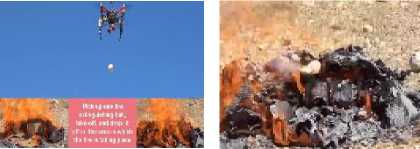
(a) (b)
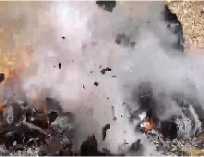
(c)
Fig.8. Snapshots of the FFD in use: (a) Hovering over a fire, (b) Dropping off the fire extinguishing ball, (c) Dispersing the fire extinguishing agent.
-
VI. Conclusion and Future Work
In this paper, we have presented a new intelligent system that will make the extinguishing process either in rugged mountainous terrains or in high-rise buildings faster, more accurate and cost effective. The system will decrease the need for firefighters to get into dangerous areas and provide an efficient way to reach the affected area within a short period of time.
The system has been designed and implemented using Quadrotor Unmanned Aerial Vehicle. Accordingly, we have developed the attached technologies that include: Robot, Automatic Electric_Spring Operated Gun, Fire Extinguishing Ball, Collision Avoidance System, and a Camera. The overall system performance tests have shown that the drone is able to get closer to the fire without endangering human lives. The current version is able to carry only one fire extinguishing ball at a time, which will force the drone to come back to the firefighter in order to continuously reload it with a new fire extinguishing ball. To overcome this problem, we have presented the concept of the fuzzy based stabilizer control system that will enable the drone to be equipped with a tray of four balls. Future work will include the testing of the tray so that the effective extinguish area can be increased.
Список литературы Fire extinguishing system for high-rise buildings and rugged mountainous terrains utilizing quadrotor unmanned aerial vehicle
- W. Marchant, S. Tosunoglu, "Rethinking Wildfire Suppression With Swarm Robotics," Proceedings of the 29th Florida Conference on Recent Advances in Robotics, FCRAR 2016, Miami, Florida, May 12-13, 2016.
- K. Chandrakanth, M. Yaswanth kumar, Ch. Mahesh, "Advanced Integrated Fire Halt Robot," International Journal on Recent and Innovation Trends in Computing and Communication IJRITCC, Volume: 4, Issue: 5, May 2016.
- C. Beltran, M. Freitas, and A. Moribe, "Unmanned Aerial Vehicle with fire Extinguishing Grenade Release and Inspection System," Florida International University, November 2013.
- Y. Akhade, A. Kasar, A. Honrao, N. Girme Fire, "Fighting Drone Using CO2 Boll Extinguisher," International Journal of Innovative Research in Computer and Communication Engineering, Volume: 5, Issue: 2, February 2017.
- S. Ogawa, S. Kudo, M. Koide, H. Torikai, and Y. Iwatani," Development and Control of an Aerial Extinguisher with an Inert Gas Capsule," Proceedings of the 2014 IEEE International Conference on Robotics and Biomimetic, Bali, Indonesia, December 5-10, 2014.
- V. Shadrin, S. Lisakov, A. Pavlov, E. Sypin, "Development of Fire Robot Based on Quadcopter," 17th International Conference on Micro/Nanotechnologies and Electron Devices EDM 2016.
- M. Li, W. Xu, K. Xu, J. Fan, and D. Hou, "Review of Fire Detection Technologies Based on Video Images," Journal of Theoretical & Applied Information Technology, vol. 49, no. 2, pp. 700-707, 2013.
- C. Yuan, Z Liu, and Y. Zhang," UAV-based Forest Fire Detection and Tracking Using Image Processing Techniques," International Conference on Unmanned Aircraft Systems (ICUAS) ,Denver Marriott Tech Center ,Denver, Colorado, USA, June 9-12, 2015.
- P. Kumar, S. Rajak, G. Kumar, T. John," Vision Based Flying Robot with Sensing Devices for Multi-purpose Application," IEEE Sponsored 2nd International Conference on Innovations in Information Embedded and Communication Systems ICIIECS’15, 2015.
- M. Abdullah, I. Wijayanto, A. Rusdinar," Position Estimation and Fire Detection Based on Digital Video Color Space for Autonomous Quadcopter Using Odroid XU4," The 2016 International Conference on Control, Electronics, Renewable Energy and Communications (ICCEREC), Bandung, Indonesia, 2016.
- P Kumar, J. Ashok, G. Narayanan," GIS based Fire Rescue System for Industries Using Quadcopter – A Novel Approach," International Conference on Microwave, Optical and Communication Engineering, Bhubaneswar, India, December 18-20, 2015.
- L. Zhang , B. Wang , W. Peng, C. Li , Z. Lu and Y Guo," Forest Fire Detection Solution Based on UAV Aerial Data," International Journal of Smart Home, Vol. 9, No. 8, pp.239-250, 2015.
- A. Ollero, J. R. Martínez-de-Dios, and L. Merino, " Unmanned Aerial Vehicles as Tools for Forest-fire Fighting," International Conference on Forest Fire Research D. X. Viegas (Ed.), 2006.
- M. Quaritsch, R. Kuschnig, H. Hellwagner, and B. Rinner," Fast Aerial Image Acquisition and Mosaicking for Emergency Response Operations by Collaborative UAVs," Proceedings of the 8th International ISCRAM Conference – Lisbon, Portugal, May 2011.
- A. Alshbatat, L. Dong, and P. Vial, "Controlling an Unmanned Quad-rotor Aerial Vehicle with Model Parameter Uncertainty and Actuator Failure," Int. J. Intelligent Systems Technologies and Applications, Vol. 15, No. 4, pp.295–322, 2016.
- A. Alshbatat, A. Soliman, and A. Al-Assaf, "Fuzzy-Based Obstacle Avoidance System for Quadrotor Unmanned Aerial Vehicle," Proceedings of 63rd ISERD International Conference, Manchester, United Kingdom, 19th-20th January 2017.

